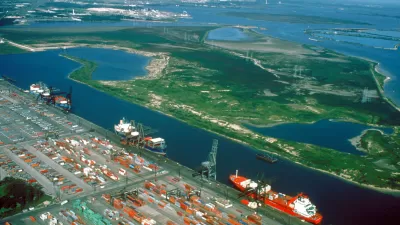The largest project ever undertaken by the Army Corps of Engineers may not be enough to protect Houston-area communities from flooding during the most severe hurricanes, according to the Corps’ own analysis.

A $31 billion flood control project known as the ‘Ike Dike,’ “a chain of sea walls and artificial dunes along the 50-mile-length of Galveston Bay, anchored by a two-mile-wide concrete gate system at the mouth of the ship channel” designed after Hurricane Ike struck the city in 2008, could still leave Houston and surrounding communities vulnerable to flooding during major storms.
As Jake Bittle explains in Grist, “Experts say the Ike Dike won’t reliably protect Houston from major storms. The barriers may not actually be tall or strong enough to handle extreme storm surge, especially as climate change makes the rapid intensification of hurricanes more likely.”
According to the Corps itself, the project “would reduce damage from medium-size hurricanes by as much as 77 percent and prevent an average of $2 billion in damages each year,” but “The Corps’ own analysis found that even with the project, the bay would still suffer an average of more than $1 billion in annual storm damage” and “the Corps’ own designs suggest it might not be able to handle storm surge from Category 4 and 5 hurricanes.”
Houston’s inland neighborhoods also face flooding risks when the city’s network of bayous swell during storms, Bittle points out. “Even as it moves forward with the Ike Dike, the Corps is looking for a way to control this urban flooding as well, but it doesn’t have many good options.”
Activists like Susan Chadwick, director of the nonprofit Save Buffalo Bayou, say “the agency should spend money on grasslands and green spaces that can soak up water across the city before it ends up in the bayous in the first place, rather than trying to control those waterways with engineered ‘gray infrastructure’,” the Corps’ preferred mode of flood mitigation.
FULL STORY: The ‘Ike Dike’ is the Army Corps of Engineers’ largest project ever. It may not be big enough.

Study: Maui’s Plan to Convert Vacation Rentals to Long-Term Housing Could Cause Nearly $1 Billion Economic Loss
The plan would reduce visitor accommodation by 25,% resulting in 1,900 jobs lost.

North Texas Transit Leaders Tout Benefits of TOD for Growing Region
At a summit focused on transit-oriented development, policymakers discussed how North Texas’ expanded light rail system can serve as a tool for economic growth.

Why Should We Subsidize Public Transportation?
Many public transit agencies face financial stress due to rising costs, declining fare revenue, and declining subsidies. Transit advocates must provide a strong business case for increasing public transit funding.

How to Make US Trains Faster
Changes to boarding platforms and a switch to electric trains could improve U.S. passenger rail service without the added cost of high-speed rail.

Columbia’s Revitalized ‘Loop’ Is a Hub for Local Entrepreneurs
A focus on small businesses is helping a commercial corridor in Columbia, Missouri thrive.

Invasive Insect Threatens Minnesota’s Ash Forests
The Emerald Ash Borer is a rapidly spreading invasive pest threatening Minnesota’s ash trees, and homeowners are encouraged to plant diverse replacement species, avoid moving ash firewood, and monitor for signs of infestation.
Urban Design for Planners 1: Software Tools
This six-course series explores essential urban design concepts using open source software and equips planners with the tools they need to participate fully in the urban design process.
Planning for Universal Design
Learn the tools for implementing Universal Design in planning regulations.
City of Santa Clarita
Ascent Environmental
Institute for Housing and Urban Development Studies (IHS)
City of Grandview
Harvard GSD Executive Education
Toledo-Lucas County Plan Commissions
Salt Lake City
NYU Wagner Graduate School of Public Service





























